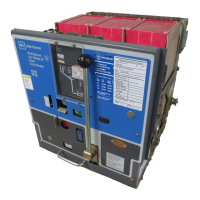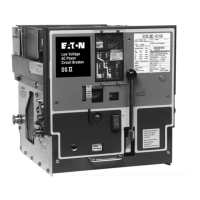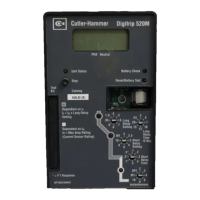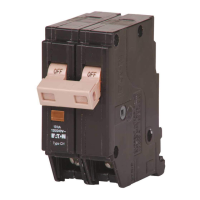1.8. 33-790-11
Fig.
67 Undervoltage Trip Device (390244)
8.7.1 Undervoltage Trip Attachment
The undervoltage trip shown
in
Figure 67 is
an
electro-
mechanical device that trips the circuit breaker when the
voltage on its coil falls to between 30 and 60 percent
of
normal. The standard unit trips instantaneously. A similar
device is also available with non-adjustable time delay
intended to ride through momentary fluctuations
of
sys-
tem voltage.
In
operation, a moving core is normally held magnetically
against a stationary core and a spring. This is linked to a
latch carrying a roller which restrains the main tripping
lever
of
this assembly.
When the coil voltage is reduced sufficiently, the torsion
spring overcomes the magnetic attraction between the
two cores. The moving core travels upward, and rotates
the latch
in
a counterclockwise direction so that the roller
moves from beneath the tail
of
the main tripping lever. A
torsion spring (not visible
in
Figure 67) around the pivot
pin
of
the tripping lever then rotates it
in
a counterclock-
wise direction, causing a projection on the right side
of
this lever to strike a pin
in
the breaker mechanism trip
shaft, and rotate the latter
in
a clockwise direction to trip
the breaker.
Effective October 1998
Page 63
SHAFT
W
POLE
-
'
BKR.
,'
\
~~;~ION
II
\\~~~SEO
POSITION
/,.
\
{,,,
11
I r.Ji(/
17--------
-
---"'\
it.+--
BKR.
CLOSED,
:,'
U.V.
ENERGIZED
,,
Fig.
68 Undervoltage Trip Device Operation
As the breaker opens, a pin
on
the left pole unit shaft
strikes a vertical leg (Reset arm)
of
the undervoltage trip-
ping lever and rotates it counterclockwise against its tor-
sion spring. Another arm on the tripping lever resets the
roller latch and the moving core. A slight amount
of
over-
travel
on
the trip latch insures positive resetting under all
conditions. Set Figure 68 for the relationship
of
the und-
ervoltage trip device, pole shaft and trip shaft.
Always connect the undervoltage coil on the line side
of
the breaker unless the attachment is equipped with a
time delay device.
In
this case, the time delay will delay
tripping
of
the breaker long enough to permit energization
of
the undervoltage coil from the load side. Do not use
an
auxiliary switch contact
in
this circuit.
8.7.2 Overcurrent Trip Switch
This device is available as an optional accessory
on
either manually operated or power-operated breakers
of
all ratings. Its function is to provide a signal to indicate
that the breaker has tripped open by action
of
the Amp-
tector trip unit due to phase
or
ground overcurrent. Nor-
mal tripping by the trip plate, shunt trip device,
undervoltage trip device, etc. does not cause it to oper-
ate. It is mounted
on
and operates from the trip actuator
of
the breaker.
Courtesy of NationalSwitchgear.com

